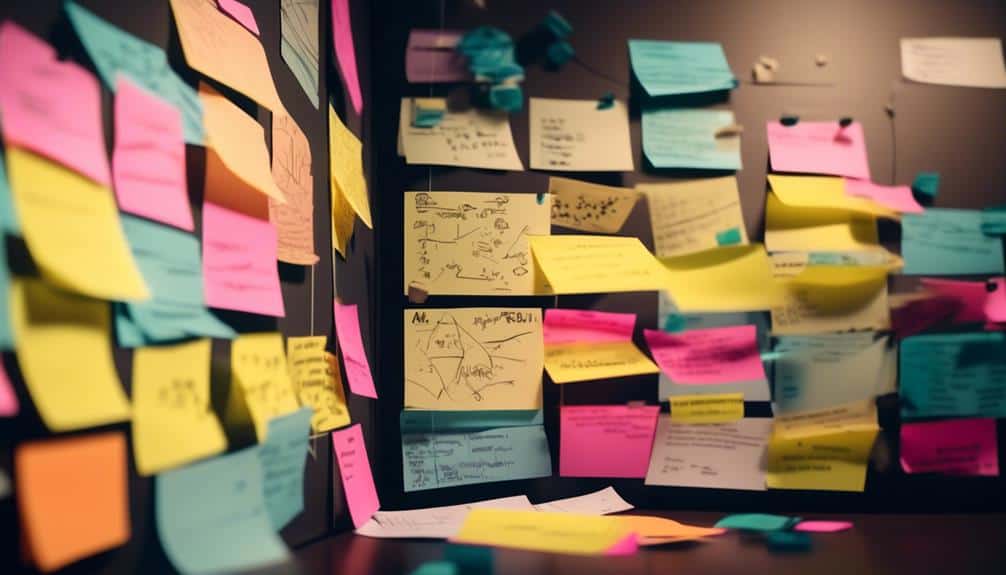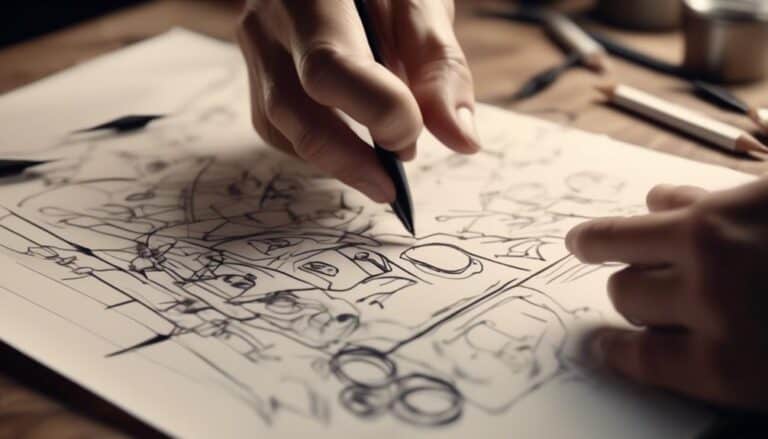Advanced Outlining Techniques for In-Depth Articles and Posts
Imagine you're a skilled architect designing a grand cathedral. Each intricate detail, from the towering spires to the delicate stained glass windows, requires meticulous planning and organization.
In the realm of crafting compelling long-form content, your approach to outlining serves as the blueprint for your literary masterpiece. As you navigate the labyrinth of advanced outlining techniques tailored for deep-diving articles and posts, you'll uncover a treasure trove of methods that promise to elevate your writing to new heights.
With tools like mind mapping, reverse outlining, and hierarchical structuring at your disposal, the possibilities for structuring your ideas are boundless.
Key Takeaways
- Mind Mapping: Utilize this powerful visual tool for brainstorming and organizing ideas to enhance creativity in a structured manner.
- Reverse Outlining: Dissect and refine existing structures by breaking down written content into main points and key ideas, then rearrange them logically to strengthen content flow.
- Hierarchical Structuring: Establish a clear and systematic framework for content organization by prioritizing information based on importance and relevance, categorizing main ideas, subtopics, and supporting details.
- Storyboarding: Use visual representation and sequencing techniques to enhance creativity and visualization in content creation.
Mind Mapping

Mind mapping is a powerful visual tool commonly used to brainstorm, organize ideas, and enhance creativity in a structured and efficient manner. When engaging in creativity exercises or brainstorming techniques, mind mapping provides a dynamic approach to generating and connecting ideas.
To begin, start with a central concept or theme in the middle of your page. This could be a problem statement, project goal, or topic of interest. Next, branch out with main ideas or subtopics related to the central theme, creating a visual representation of how these concepts interconnect.
As you continue to expand on each branch, consider adding keywords, images, or colors to stimulate different parts of your brain and promote innovative thinking. By incorporating various brainstorming techniques within your mind map, such as lateral thinking or reverse brainstorming, you can push the boundaries of conventional ideas and uncover unique solutions.
Reverse Outlining
To enhance your outlining skills further, consider implementing the strategic approach of Reverse Outlining to dissect and refine your existing structures for improved clarity and organization. Reverse Outlining involves breaking down your already written content into its main points and key ideas. It's like reverse engineering your outline to ensure that each part supports your main argument or message effectively.
Start by reviewing your draft and creating a list of the main points or arguments you've made. Then, rearrange these points in a logical order to strengthen the flow of your content. This process helps you identify any gaps or inconsistencies in your writing, allowing you to address them more efficiently.
Additionally, Reverse Outlining enables you to conduct content analysis by evaluating the relevance and coherence of each section. By examining your content in this manner, you can ensure that every paragraph contributes meaningfully to your overall message. This method complements traditional outlining techniques by providing a different perspective on your writing, ultimately leading to more coherent and well-structured articles.
Chunking

Consider incorporating the technique of Chunking into your outlining process to efficiently organize and structure your content for enhanced readability and comprehension. Chunking involves breaking down large pieces of information into smaller, manageable chunks, making it easier for your audience to digest your content.
Here's how you can utilize Chunking effectively:
- Creative Brainstorming: Start by jotting down all your ideas related to the topic. Allow your thoughts to flow freely without worrying about structure at this stage.
- Strategic Organization: Once you have a pool of ideas, group related concepts together. This step helps in identifying the main themes or sections your content will cover.
- Chunk Creation: Create distinct sections within your outline based on the grouped ideas. Each chunk should represent a cohesive unit of information.
- Smooth Transitions: Ensure that there are logical connections between each chunk to maintain a smooth flow throughout your content.
Hierarchical Structuring
Hierarchical structuring enhances the organization of your content by establishing a clear and systematic framework that prioritizes information based on levels of importance and relevance. When delving into hierarchical structuring, think of it as creating a roadmap for your readers, guiding them through your ideas in a structured and logical manner. Utilizing techniques like concept mapping and brainstorming can help you visualize the hierarchy of your content before diving into the actual writing process.
Consider using a tree diagram to categorize your main ideas, subtopics, and supporting details. This visual representation can aid in determining the relationships between different pieces of information and assist in maintaining a cohesive flow throughout your article. By structuring your content hierarchically, you ensure that your audience can easily follow the progression of your thoughts, making complex topics more digestible and engaging.
| Main Ideas | Subtopics | Supporting Details |
|---|---|---|
| Introduction | Definition | Importance |
| Benefits | Increased clarity | Enhanced readability |
| Implementation | Step 1 | Example 1 |
Topical Clustering

Navigating through your content like a well-marked path, Topical Clustering brings a new dimension of organization by grouping related ideas together for a cohesive and impactful presentation. When employing this method, you strategically categorize your content into clusters, ensuring a logical flow and enhancing the overall readability. Here's how you can leverage Topical Clustering to elevate your writing:
Topical Clustering Techniques:
- Cluster Organization: Arrange your content into distinct clusters based on related topics or themes, allowing for a more structured and organized piece.
- Topic Grouping: Group similar ideas under overarching topics to create a coherent narrative that guides your readers seamlessly through the content.
- Enhanced Connectivity: Establish clear connections between clustered topics to provide a holistic view of the subject matter and foster a deeper understanding.
- Visual Hierarchy: Utilize visual aids such as bullet points, subheadings, or diagrams to visually represent the clustered information and aid in comprehension.
Parallel Structures
When outlining with parallel structures, you create a harmonious flow in your writing by using balanced sentence structures and symmetrical patterns.
This technique enhances readability and adds a sophisticated touch to your work.
Balanced Sentence Structures
To enhance the impact of your writing, master the art of creating balanced sentence structures, also known as parallel structures. When you utilize balanced sentence structures, you not only enhance the readability of your content but also make your writing more persuasive and engaging.
Here are four key benefits of incorporating balanced sentence structures in your writing:
- Rhetorical devices: By using parallel structures, you can effectively employ rhetorical devices to emphasize your points.
- Enhancing clarity: Parallel structures in your sentences can significantly enhance the clarity of your writing, making it easier for your audience to follow your ideas.
- Creating a rhythmic flow: Balanced sentence structures help in creating a rhythmic flow in your writing, capturing and maintaining the reader's attention.
- Improving memorability: When you use parallel structures, your writing becomes more memorable and impactful, leaving a lasting impression on your audience.
Symmetrical Writing Patterns
Mastering balanced sentence structures not only enhances the impact of your writing but also sets the foundation for incorporating symmetrical writing patterns, known as parallel structures, into your work. Parallel structures create mirror images within your writing, promoting bilateral symmetry and a seamless writing flow. By using parallel structures, you can elevate your content to new heights of creative expression. To better understand this concept, let's explore a comparison between balanced and parallel structures:
| Balanced Structures | Parallel Structures |
|---|---|
| Adds variety to sentences | Enhances readability |
| Creates a sense of equilibrium | Establishes rhythm |
| Emphasizes individuality of ideas | Highlights connections |
| Provides a natural cadence | Ensures consistency |
| Improves overall writing quality | Elevates writing style |
Storyboarding

Storyboarding enhances your ability to visualize the flow and structure of your ideas in a dynamic and organized manner. By incorporating this technique into your creative brainstorming process, you can bring a new level of clarity and depth to your content creation. Here are four key reasons why storyboard is an essential tool for crafting compelling narratives:
- Visual Representation: Storyboarding allows you to see your ideas laid out visually, making it easier to spot gaps or areas that need further development.
- Sequencing: It helps you arrange your thoughts in a sequential order, ensuring a logical flow in your content.
- Enhanced Creativity: By visually mapping out your ideas, you can uncover new connections and creative possibilities that may have been overlooked in a traditional outline.
- Collaboration: Storyboarding is an excellent way to collaborate with team members, as it provides a shared visual reference that can streamline the content creation process.
Embrace the power of storyboarding to elevate your content creation process and unlock new levels of innovation and creativity.
Progressive Detailing
Progressive detailing enhances the depth and intricacy of your outlines by gradually expanding on key points and refining your ideas with increasing specificity. This technique allows for thematic expansion, where you delve deeper into the central themes of your content, enriching the overall narrative. Through conceptual elaboration, you can provide a more comprehensive understanding of complex ideas, ensuring that your audience gains a profound insight into the subject matter.
Layered exploration is another vital aspect of progressive detailing. By adding layers of information to your outline, you create a multifaceted piece that captivates readers and keeps them engaged. This nuanced examination of different facets of your topic not only showcases your expertise but also adds depth to your content, making it more valuable to your audience. Each layer contributes to the richness of your outline, offering a holistic view that leaves a lasting impression on your readers. Embrace progressive detailing to craft outlines that aren't just informative but also compelling and thought-provoking.
Visual Outlining

As you refine your outlines with progressive detailing techniques, consider incorporating Visual Outlining to elevate the impact of your content through strategic visual representation. Visual Outlining utilizes color coded organization and brainstorming techniques to enhance the structure and creativity of your work.
Key Elements of Visual Outlining:
- Color Coded Organization: Implement color schemes to categorize different sections or ideas within your outline. This visual differentiation helps in quickly identifying and understanding the relationships between different parts of your content.
- Mind Mapping: Use brainstorming techniques like mind mapping to visually represent ideas and their connections. Mind maps are a powerful way to visualize the flow of your content and generate new insights.
- Flowcharts: Create flowcharts within your outline to illustrate processes, sequences, or hierarchies. Flowcharts provide a clear visual representation of how different elements in your content are interconnected.
- Visual Hierarchy: Utilize visual hierarchy techniques such as varying font sizes, bolding, or bullet points to emphasize the importance and relationships between different points in your outline. Visual hierarchy aids in guiding the reader through your content effectively.
Recursive Revision
When revising your outline recursively, focus on systematically reviewing and refining the content to enhance clarity and coherence. To employ effective revision techniques, first, scrutinize the main points and subpoints within your outline. Ensure that each idea flows logically from one to the next, creating a seamless progression of thoughts. Next, assess the supporting details under each subpoint, verifying that they contribute directly to the overarching theme or argument. Eliminate any redundant or irrelevant information to maintain a concise and focused outline.
As you engage in recursive outlining, consider the overall structure of your content. Are there opportunities to reorganize sections for better flow? Could certain points be grouped together more effectively? By continuously revising and adjusting your outline, you can refine the narrative and strengthen the coherence of your piece. Additionally, pay attention to transitions between different sections to guarantee a smooth transition between ideas.
Through meticulous attention to detail and a commitment to clarity, your recursive revision process will elevate the quality of your work to new heights.
Frequently Asked Questions
How Can I Effectively Incorporate Storytelling Into My Outline?
When outlining, ensure storytelling by integrating character development for depth and plot progression for intrigue. Infuse emotional impact to captivate readers and boost engagement. This strategic approach elevates your content to resonate with innovation-seeking audiences.
What Are Some Strategies for Maintaining Consistency and Flow Throughout a Long and Detailed Article?
To maintain consistency and flow in your detailed article, infuse storytelling elements throughout and collaborate with others for feedback. This strategy ensures a cohesive narrative and engages readers from start to finish, making your content more impactful.
How Can I Ensure That My Outline Captures the Main Ideas and Supporting Details Without Becoming Too Overwhelming?
To ensure your outline captures main ideas without overwhelm, start with idea generation using brainstorming techniques. Incorporate visuals such as graphic organizers for clarity. By organizing thoughts strategically and engagingly, you'll create an innovative structure.
Are There Any Tools or Software Programs That Can Assist With Creating and Organizing Complex Outlines?
When tackling complex outlines, online tools and software programs can be game-changers. They offer visual organization through mind mapping, ensuring your ideas flow seamlessly. These innovative resources streamline the outlining process, making it both efficient and effective.
How Can I Use Outlining Techniques to Enhance Collaboration and Feedback From Others During the Writing Process?
To boost collaboration and feedback, outline with clear headings, subpoints, and questions for input. Share the outline early for feedback. Encourage others to add notes directly. Use color-coding or symbols for easy tracking and discussion.
Conclusion
In conclusion, by utilizing advanced outlining techniques such as:
- Mind mapping
- Reverse outlining
- Chunking
- Hierarchical structuring
- Topical clustering
- Storyboarding
- Progressive detailing
- Visual outlining
- Recursive revision
you can create in-depth and organized articles and posts. These methods help you to effectively plan and structure your content, ensuring that your message is clear, engaging, and easy to follow for your readers.
Embrace these techniques to take your writing to the next level.








